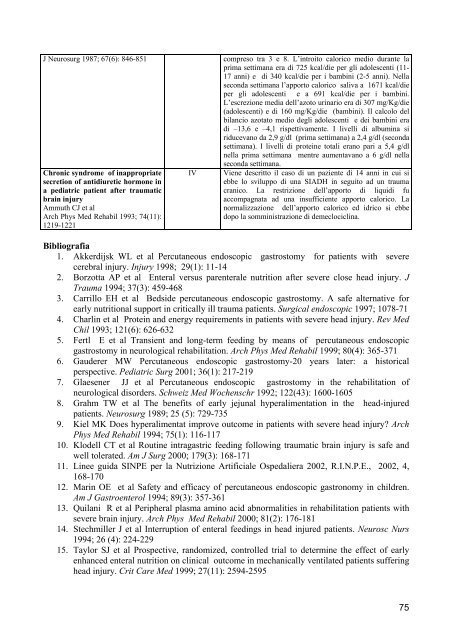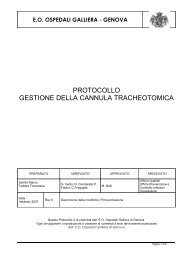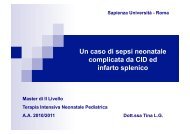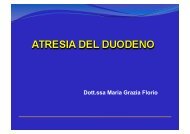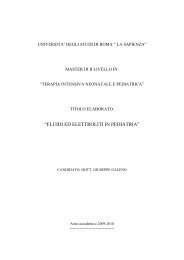Linee guida trauma cranico pediatrico grave SIAARTI-SARNEPI
Linee guida trauma cranico pediatrico grave SIAARTI-SARNEPI
Linee guida trauma cranico pediatrico grave SIAARTI-SARNEPI
You also want an ePaper? Increase the reach of your titles
YUMPU automatically turns print PDFs into web optimized ePapers that Google loves.
J Neurosurg 1987; 67(6): 846-851<br />
Chronic syndrome of inappropriate<br />
secretion of antidiuretic hormone in<br />
a pediatric patient after <strong>trauma</strong>tic<br />
brain injury<br />
Ammuth CJ et al<br />
Arch Phys Med Rehabil 1993; 74(11):<br />
1219-1221<br />
compreso tra 3 e 8. L’introito calorico medio durante la<br />
prima settimana era di 725 kcal/die per gli adolescenti (11-<br />
17 anni) e di 340 kcal/die per i bambini (2-5 anni). Nella<br />
seconda settimana l’apporto calorico saliva a 1671 kcal/die<br />
per gli adolescenti e a 691 kcal/die per i bambini.<br />
L’escrezione media dell’azoto urinario era di 307 mg/Kg/die<br />
(adolescenti) e di 160 mg/Kg/die (bambini). Il calcolo del<br />
bilancio azotato medio degli adolescenti e dei bambini era<br />
di –13,6 e –4,1 rispettivamente. I livelli di albumina si<br />
riducevano da 2,9 g/dl (prima settimana) a 2,4 g/dl (seconda<br />
settimana). I livelli di proteine totali erano pari a 5,4 g/dl<br />
nella prima settimana mentre aumentavano a 6 g/dl nella<br />
seconda settimana.<br />
IV Viene descritto il caso di un paziente di 14 anni in cui si<br />
ebbe lo sviluppo di una SIADH in seguito ad un <strong>trauma</strong><br />
<strong>cranico</strong>. La restrizione dell’apporto di liquidi fu<br />
accompagnata ad una insufficiente apporto calorico. La<br />
normalizzazione dell’apporto calorico ed idrico si ebbe<br />
dopo la somministrazione di demeclociclina.<br />
Bibliografia<br />
1. Akkerdijsk WL et al Percutaneous endoscopic gastrostomy for patients with severe<br />
cerebral injury. Injury 1998; 29(1): 11-14<br />
2. Borzotta AP et al Enteral versus parenterale nutrition after severe close head injury. J<br />
Trauma 1994; 37(3): 459-468<br />
3. Carrillo EH et al Bedside percutaneous endoscopic gastrostomy. A safe alternative for<br />
early nutritional support in critically ill <strong>trauma</strong> patients. Surgical endoscopic 1997; 1078-71<br />
4. Charlin et al Protein and energy requirements in patients with severe head injury. Rev Med<br />
Chil 1993; 121(6): 626-632<br />
5. Fertl E et al Transient and long-term feeding by means of percutaneous endoscopic<br />
gastrostomy in neurological rehabilitation. Arch Phys Med Rehabil 1999; 80(4): 365-371<br />
6. Gauderer MW Percutaneous endoscopic gastrostomy-20 years later: a historical<br />
perspective. Pediatric Surg 2001; 36(1): 217-219<br />
7. Glaesener JJ et al Percutaneous endoscopic gastrostomy in the rehabilitation of<br />
neurological disorders. Schweiz Med Wochenschr 1992; 122(43): 1600-1605<br />
8. Grahm TW et al The benefits of early jejunal hyperalimentation in the head-injured<br />
patients. Neurosurg 1989; 25 (5): 729-735<br />
9. Kiel MK Does hyperalimentat improve outcome in patients with severe head injury? Arch<br />
Phys Med Rehabil 1994; 75(1): 116-117<br />
10. Klodell CT et al Routine intragastric feeding following <strong>trauma</strong>tic brain injury is safe and<br />
well tolerated. Am J Surg 2000; 179(3): 168-171<br />
11. <strong>Linee</strong> <strong>guida</strong> SINPE per la Nutrizione Artificiale Ospedaliera 2002, R.I.N.P.E., 2002, 4,<br />
168-170<br />
12. Marin OE et al Safety and efficacy of percutaneous endoscopic gastronomy in children.<br />
Am J Gastroenterol 1994; 89(3): 357-361<br />
13. Quilani R et al Peripheral plasma amino acid abnormalities in rehabilitation patients with<br />
severe brain injury. Arch Phys Med Rehabil 2000; 81(2): 176-181<br />
14. Stechmiller J et al Interruption of enteral feedings in head injured patients. Neurosc Nurs<br />
1994; 26 (4): 224-229<br />
15. Taylor SJ et al Prospective, randomized, controlled trial to determine the effect of early<br />
enhanced enteral nutrition on clinical outcome in mechanically ventilated patients suffering<br />
head injury. Crit Care Med 1999; 27(11): 2594-2595<br />
75


